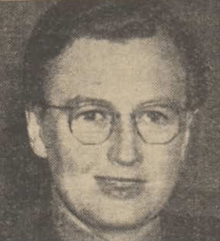Kathleen Best
Colonel Matron Kathleen Annie Louise Best, OBE, RRC (28 August 1910 – 15 November 1957) was the first director of the Women's Royal Australian Army Corps.
Kathleen Best | |
|---|---|
 | |
| Born | 28 August 1910 Summer Hill, New South Wales |
| Died | 15 November 1957 (aged 47) Epworth Hospital, Richmond, Victoria |
| Buried | |
| Allegiance | Australia |
| Service/ | Second Australian Imperial Force Women's Royal Australian Army Corps |
| Years of service | 1940–1944 1951–1957 |
| Rank | Colonel Matron |
| Unit | Australian Army Nursing Service |
| Commands held | Women's Royal Australian Army Corps (1951–57) |
| Battles/wars | Second World War |
| Awards | Officer of the Order of the British Empire Royal Red Cross |
Early life
Best was born at Summer Hill in Sydney on 28 August 1910. Best was educated in Sydney and undertook nursing training at Western Suburbs Hospital and midwifery training in the Crown Street Women's Hospital. Having completed her training, Best nursed at Wyong Hospital on the New South Wales central coast, was appointed Acting Matron at the Rachel Forster Hospital in Sydney and later Deputy-Matron at the Masonic Hospital in Ashfield.[1]
Second World War
Best's military nursing career began with her appointment to the Australian Army Nursing Service on 30 May 1940, during the Second World War. She was posted as matron to the 2/5th Australian General Hospital and embarked for the Middle East in October that year. After opening in Palestine in December 1940, the hospital moved to Greece in April 1941. During the short-lived campaign, Best – the senior matron in Greece – and her colleagues endured regular German air raids. Best and 39 colleagues volunteered to remain in Greece after the evacuation knowing that they risked captivity. Within hours of deciding to stay, however, they too were ordered to leave, the last Australian nurses to do so. They survived further German air attacks on their ship before reaching Crete and later Alexandria, Egypt. Best was awarded the Royal Red Cross for her service in the Greek campaign.
The 2/5th Australian General Hospital was then re-established in Palestine and reorganised under Best's supervision, but in August 1941 moved again, this time to Eritrea on the African coast. By March 1942 Best had returned to Australia, where her appointment to the AIF was terminated in mid-June. This, however, was not the end of her contribution to Australia's war effort. A month after leaving the AIF she became the Controller of full-time Voluntary Aid Detachments, which in September became part of the Australian Army Medical Women's Service.[2]
Best held this post for seven months until she received a promotion to lieutenant colonel in February 1943 and was posted as Assistant Adjutant General (Women's Services) at Land Headquarters in Melbourne, Australia.[3] In September 1944, she became Assistant Director of Women's Re-establishment and Training for the Department of Postwar Reconstruction. Among her responsibilities was the task of assisting servicewomen and female war-workers to adjust to civilian life once the war ended.[4]
Later life
On 12 February 1951, Best became the founding Director of the Australian Women's Army Corps, which was shortly after given the designation "Royal". In September 1952 she reached the rank of honorary colonel and four years later, in 1956, appointed Officer of the Order of the British Empire. In 1954 Best became chairman of the Red Cross Button Day committee in Melbourne.[5] Despite her achievements Best has been described as a modest woman with an engaging sense of humour. Those who served under her considered Best an inspiring leader who ruled with a firm hand, but who also treated her subordinates with fairness. A memorial gateway commemorating her service was constructed at the entrance to the WRAAC School at George's Heights in Sydney, Australia.[6]
Death
Best became ill and died of melanomatosis on 15 November 1957, aged 47, at Epworth Hospital in Richmond, Melbourne.[7]
Sources
- "Honour For Matron". The Sydney Morning Herald (32, 454). New South Wales, Australia. 2 January 1942. p. 3. Retrieved 1 May 2019 – via National Library of Australia.
- "New V.A.D. Head For Hospitals". The Herald (20, 321). Victoria, Australia. 2 July 1942. p. 8. Retrieved 1 May 2019 – via National Library of Australia.
- "Interesting People". The Australian Women's Weekly. 10 (41). Australia, Australia. 13 March 1943. p. 20. Retrieved 1 May 2019 – via National Library of Australia.
- "Lieut-Colonel K. Best For Postwar Job". The Argus (Melbourne) (30, 567). Victoria, Australia. 16 August 1944. p. 8. Retrieved 1 May 2019 – via National Library of Australia.
- "200,000 Flags to Sell". The Herald (23, 908). Victoria, Australia. 11 January 1954. p. 11. Retrieved 1 May 2019 – via National Library of Australia.
- Dennis, Peter (2008). The Oxford Companion to Australian Military History. Melbourne, Australia: Oxford University Press. p. 87. ISBN 9780195517842.
- Lincoln, Merrilyn (1993). "Best, Kathleen Annie Louise (1910–1957)". Australian Dictionary of Biography. 13. Melbourne University Press. ISSN 1833-7538. Retrieved 5 April 2019 – via National Centre of Biography, Australian National University.
- Article on Colonel Matron Kathleen Annie Louise Best in the Daily Telegraph Mirror, Tuesday 31 October 1995, p. 34
| Military offices | ||
|---|---|---|
| New office | Director of the Women's Royal Australian Army Corps 1951–1957 |
Succeeded by Colonel Dawn Jackson |